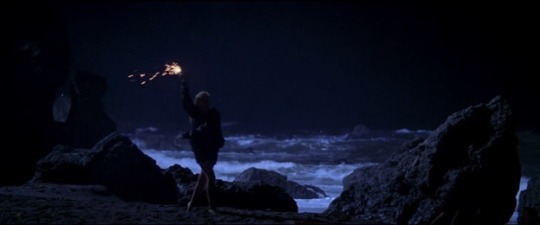#denis crossan
Photo










Prey for the Devil (Daniel Stamm, 2022).
#prey for the devil#daniel stamm#jacqueline byers#denis crossan#tom elkins#lora venkova#elena stoyanova
14 notes
·
View notes
Text
youtube
COMMENTARY:
Bart Ehrman's entire these, based on the probable effects of his particular academic focus, textual analysis, si the major driver of the Gospels. narrative. His claim that the original military report from Pilate to Tiberius on a euangelion FLASH signal deviated a jot or a it tittle from the devine trajectory from Mark 15:39 byway of the Talking Cross. This was a common vision of the 16 Roman soldiers and centurion, the equivalent of two rigle squads and a SFC. The centurion was a fusion of a warrant officer in the US Army and a SFC or higher NCO> The ceenturion was in charge of Jesus' death sentence and had the Death Warrant DCSXVI and the authority and duty to exectue it. Nice and Legan. We no longer have those Roman records but they can be inferred from the circumstances and characteristic paper work of a modern federal bureaucracy. You don't have to believe me: ask Max Weber.
The Gospel of Mark is an official war story that was staffed out to collect as much intelligence as possible about Jesus after the fact of the Talking Cross. Even John Dominic Crossan cannot deny the Talking Cross, if only as oral tradition in the Roman military to the Apostle's Creed. ,
Here is the thing about historians like Bart Ehrman, which is basically everybody Pro'-Life Calvinism is that a dangling question in the academic lounges is trying to determine the influence of Aristotle on Alexander the Great, That's characteristic of critical historic analysis, a subset of dialectic materialism employed by Marx.
N.T. Wright employs the critical historic method from the dialectical Idealism contrasting to dialectical materialism. As a process theology guru, I employ the Hegelian critical literary method of dialectical synthesis. Everywhere Alexander went, he established Greek colonies with retired military that had blended into the economy in a La Dolce Vita kind of way. In Acts 10, Cornelius is living large in the regional culture, He had seconded there with Pilate and loved the Lord going back to when Jesus healed a favorite child of Cornelius's household, He was in the room with Pilate in Mark 15. Everything from Mark 15:1 to 16:8 is the spinal narrative of what Pilate reported to Tiberius in 33: CE according to astronomy. The stuff that is in the Gospel of Peter has been deliberately purged by Cornelius for official reports. Being a Christian was dangerous and became a death sentence under Nero but going back to Sejanus. Sejanus is the reason why Roman society hated Christians 15 years before the slur surfaced in the collective consciousness o Jesus followers in the social footprint of John the Baptist described in Mark 3:8. The 10th Legion wrote the bood on the sociology and anthropology of the Jesus Followers in their Ara of Operations, wheich stretched from Capernaum to the walls of the Mount of OlivesI agree with James Tabor, I believe Jesus was cricified at this gate and the 10th Legion was in charge.
The scuttlebutt of the Talking Cross went through the 10th Legion like Legion into the pigs. This is awonderful example of the sense of humor of the Holy Spirit is partnership with Cornelius in the final version delivered to Rome just before Claudius became Emperor and would carry Christianity into Britain, where Christian centurions like Cornelius throughout the Roman Empire would marinate in the Druid culture and win the battle of the Milvian Bridge behind the XP talisman of Boudicca, Queen of Battle.
The synagogues are a cultural appropriation of Greek culture of the city state that Alexander employed everywhere he went and one of the tings Jesus was trying to do was to transform the economics of Judaism from the vertical structures of Temple Worship/Tower of Babel fascism for the synthesis of the horizontal and vertical structures of the Greek city state, Virginian's Commonwealth legal organization is all Aristotle by way of Alexander the Great.
And Bart Ehrman's version of Jesus ignores all that actual real time history as part of a 60s academic agenda that goes back to the Weather Underground and is connected to antifa. They are the left wing version of the January 6 MAGA Conservatives and neo=Nazi Pro=life Calvinists. The Jesus Seminar is a primary source of the moral confusion that allowed David Koresh to fester.
The Jesus Seminar isn't pro=Trump, It is pro-Atlas Shrugged in a Left Behind Beam Me Up, Jesus kind of way.
0 notes
Photo










**Shots of the Movie**
I Know What You Did Last Summer (1997)
Director: Jim Gillespie
Cinematographer: Denis Crossan
#shots of the movie#i know what you did last summer#jim gillespie#denis crossan#kevin williamson#jennifer love hewitt#freddie prinze jr.#ryan phillippe#sarah michelle gellar#muse watson#stills#anne heche#bridget wilson-sampras#screencaps#screenshots#horror#movie stills#film stills#film#shot on film#cinema#cinematography#1990s cinema#1990s film#1997 in film#1997 film#1997#2.39:1
41 notes
·
View notes
Photo


Me Without You (2001) dir. Sandra Goldbacher
#me without you#sandra goldbacher#cinematography#denis crossan#british cinema#michelle williams#anna friel#film stills#movies#aesthetic
801 notes
·
View notes
Photo

I Know What You Did Last Summer (1997)
#i know what you did last summer#Ryan Phillippe#jim guillespie#cinematography#denis crossan#beautiful cinematography#cool cinematography#Shower#Shower Scene#film frames#movie stills#slasher movies#1997 movies#shirtless man
12 notes
·
View notes
Photo

Me Without You (2001 Film) by Sandra Goldbacher
#Me Without You#Sandra Goldbacher#michelle williams#Denis Crossan#Oliver Milburn#indie movie#indie film#movies#film#cinema#Arts#film making#Amazon Prime#movie stills#film stills
44 notes
·
View notes
Text
Emily VanCamp Weighs in on Why Sharon Carter Doesn't Need a Love Interest (Exclusive)
Last we saw Sharon Carter in the MCU, she'd stolen Steve Rogers' (Chris Evans) star-spangled shield for him and he'd warned her the government was going to come looking for her. And then they kissed -- though it was a kiss that became a kiss off as a handful of movies passed, a global Blippening came and went, and Steve ghosted Sharon for her aunt.
Now, Sharon is back in The Falcon and the Winter Soldier, though this version of the one-time S.H.I.E.L.D. agent -- living as a fugitive on the lawless island nation of Madripoor -- is more like to steal from you (and/or kill you) than steal for you. "It's been a minute!" says Emily VanCamp, reprising her role as Sharon. Reluctantly, Sharon is dragged into Sam Wilson (Anthony Mackie) and Bucky Barnes' (Sebastian Stan) latest adventure as their paths cross over a rogue super soldier serum and a shadowy bad guy known as the Power Broker.
"I'm so happy that people are happy to have Sharon back. You never know. It's a very particular fandom and you want to make 'em proud," she tells ET. "It's really nice to hear that people are glad she's back, because I certainly had a great time coming back to do this."
Following her return in episode three, "Power Broker," VanCamp spoke with ET's Ash Crossan by Zoom to discuss embodying a very different Sharon Carter and why she doesn't need a love interest this time around.
ET: Sharon has lived since we last saw her. How in-depth did you go with Kari [Skogland, director] and Malcolm [Spellman, head writer] about everything Sharon's been doing since Civil War?
I remember sitting down with Kari right before we started shooting -- and we'd talked about it at length with our producers and everything before I even came onboard to do it -- it was like, what are we doing here with Sharon? Are we going to address everything? How is this going to work? And I loved everything they had pitched, which was, "Look, she's been a fugitive on the run this entire time, so when we meet Sharon again, it's a very different Sharon than we've seen before." And I do think they really came through on that. We don't dive too much into where she's been, but you certainly get a sense that it hasn't been easy. It's a hardened version of Sharon. She's not so wide-eyed and idealistic as she once was, because obviously, she's been through it and hasn't gotten that pardon that she wants. She's been on the run, so you can imagine.
You touched on this, but what question did you have about?
So much about where has she been? Why wasn't she pardoned? What has she been doing? How has she survived? Just so many different things. And we touch on it a little bit -- that she hasn't been able to speak to her family. That she's been on the run all on her own, and no one was there to come and rescue her. That's the sort of idea in her mind. And I was just trying to infuse all of that bitterness into who Sharon once was and marry those ideas.
I love that Bucky is like, "Wow, she's kind of awful now." Like, no, she's amazing.
Yeah, and of course, as the person playing the character, I'm like, "Well, you're awful!" [Laughs] You inevitably become protective of the characters you're playing. I love that he says that, because it's true! She's just a very different Sharon, and there's no denying it.
I know you got a lot of love from fans after the episode. Do you think that Sharon was underestimated before?
I wouldn't say underestimated. I just think those movies are so big with so many characters to service and so many stories to tell that it's just hard to fit everyone in. There wasn't so much room to develop Sharon, so I don't think it's anyone's fault, I just think, you know, it's nice that with this platform, they're able to go a little bit deeper into some characters that maybe we haven't gotten to see in the movies, just because of time.
Well, there was the romance between Sharon and Steve that didn't really take off. But now people are sensing some tension between Bucky and Sharon, especially since the first episode focused on him being single. Some feeling Sam and Sharon. Do you think there's a connection there? Does she even need a love interest, honestly?
[Shaking her head] No! She doesn't need a love interest. We already tried that with Steve. It just got way too weird. And honestly, I think that one of the nice things about this Sharon and coming back to play this character is that we get to move away from the sort of love story of it all and explore Sharon as we see her now and what she's been through. It's more about that than trying to establish some kind of love connection. And it also would take away from their journeys, as well. They're both on their own separate journeys and together, and so it just-- I personally [think] there wouldn't have been room for that.
I'm more into where Sharon is going. Are we going to get more insight into how she became this arts dealer hustler in Hightown? I mean, there are a lot of theories floating around about Sharon.
There are! And I love that there are theories already floating around. That means people are talking about it, which is awesome. I can't say anything beyond that, actually. [Laughs] I'm trying to think of, like, what I can say. I definitely don't want to give anything away. I will say there are more characters to come, which is exciting. The beautiful thing about this show, too, is how gray everything is. Even who we might consider to be a villain, there's just a really good handle on every character's perspective and reasoning and I just find that much more interesting than black-and-white villain versus hero.
You're so right. Because I never thought we'd get to a point where people are loving Zemo and hating Captain America!
I know! It's crazy! But that's the cool thing about what Marvel is doing, especially with these shows. It's really interesting.
Do you have a favorite fan theory you've read so far about the show?
Oh gosh. I'm not, like, as knowledgeable as I should be about the comic book world, so sometimes I don't even know what some of the theories are. But no, I'd rather just let everyone watch and see what happens. Because if I start talking too much, then I'll give stuff away. [Laughs]
I'm all aboard the Sharon is Power Broker theory. I love it. If she wants to be, yes. She can have whatever she wants.
Whatever Sharon wants! I love that theory. Just whatever she wants.
source
16 notes
·
View notes
Text
List of some Modern-day False Teachers

"But there were also false prophets among the people, even as there will be false teachers among you, who will secretly bring in destructive heresies... "
- 2 Peter 2:1
Here is a list of of the more obvious heretics/false teachers to be marked & avoided: (not exhaustive)
Angley, Ernest [Word of Faith]
Armstrong, Karen [Progressive]
Arnott, John [leader Toronto “Blessing”, Latter Rain]
Bakker, Jamie [Emergent Church]
Bakker, Jay [Emergent Church, neo-liberal]
Bakker, Jim [Prosperity Theology]
Bell, Rob [Progressive Christian, Emergent Church]
Borg, Marcus J . [Liberal Christian]
Burke, Spencer [Emergent Church]
Boyd, Gregory A. [Open Theist]
Camping, Harold [false prophet]
Campolo, Tony [Progressive Christian]
Chalke, Steve [rejects penal substitution and biblical Inerrancy; supports same sex unions]
Cho, Paul or David Yonggi [Word of Faith, pastor of largest church in the world]
Claiborne, Shane [Progressive Christian]
Clement, Kim [New Apostolic Reformation]
Copeland, Kenneth and Gloria [Word of Faith]
John Dominic Crossan [Liberal Theology]
Crouch, Paul Jr. [promotes Prosperity heresies via TBN]
Crouch, Paul Sr. [Properity Teacher, TBN founder]
Crowder, John [New Mystics, Sons of Thunder]
Deere, Jack [Latter Rain, Wimberite]
Dollar, Creflo [Prosperity Teacher]
Dowd, Michael [Progressive Christian]
Eddy, Mary Baker [“Christian” Science; mind sciences]
Evans, Rachel Held [Progressive "Christian", Political Idolatry]
Furtick, Steven [ narcissistic "gospel" devoid of much Biblical truth]
Hagee, John [False Prophet, Uber-Pentecostal, Ultra-Dispensationalist]
Hagin, Kenneth Jr./Sr. [Prosperity]
Hatmaker, Jen [works righteousness, progressive, affirms same-sex marriage]
Hick, John [Progressive Christian]
Hinn, Benny [Prosperity Teacher, Uber Charismatic]
Hollis, Rachel [self-help, self-care, self-love. prosperity]
Hybels, Bill [Seeker Sensitive]Jacobs, Cindy [Prosperity]
Jakes, TD [Oneness Pentecostalism]
John Pavlovitz [Progressive activist; witholds gospel from persons identifying as LGBTQ]
Johnson, Bill [New Apostolic Reformation, Kenosis, Word of Faith] -
more..
Kimball, Dan [Emergent Church]
Lane Craig, William [Trinitarian Errors, Partialism, Neo-Apollinarianism, Molinism]
Long, Bishop Eddie [Prosperity Uber Charismatic]
McClure, Joel [Emergent Church]
Mclaren, Brian [Emergent Church]
McManus, Erwin [Mystic Contemplative Prayer Movement]
Merritt, Jonathan [Pelagian, Progressive Christian]
Merton, Thomas [Trappist monk and Catholic mystic]
Micah, Jory [denies inerrancy, Feminist, Christological heresy, ambiguous about acsended Jesus having physical body, Jesus is genderless]
Miller, Donald [Progressive Christian]
Meyer, Joyce [Prosperity Preacher]
Nouwen, Henry [Contemplative Mysticism, Emerging Church]
Osteen, Joel [cotton candy theology, bible compromiser, name it & claim it, soft moralism]
Pagitt, Doug [Emergent Church]
Peale, Norman Vincent [positive confession liberal]
Pearson, Carlton [Universalism]
Popes, all [idolaters, antiChrists]
Price, Fred KC [Prosperity Preacher, Name it & claim it]
Prince, Joseph [Prosperity, Antinomianism]
Roberts, Oral [deceased, false prophet]
Robertson, Pat [divination, false prophet, TBN]
Rohr, Richard [Progressive Christian]
Roth, Sid [mystic, NAR]
Russell, Charles Taze [founder Jehovah’s Witnesses]
Rutherford, Judge [past president of Jehovah’s Witnesses]
Scandrette, Mark [Emergent Church]
Schuler, Robert [Peale clone, liberal theology]
Spong, John Shelby (1931–)
Stanley, Andy [Marcionite, carnal Christianity]
Sweet, Leonard [Emergent Church]
Tenney, Tommy [Oneness Pentecostalism, Charismatic]
Vines, Matthew [Liberal]
Wallis, Jim [Progressive Christian, Left-Wing Political idolatry]
Warren, Rick [Emergent Purpose Driven]
Webber, Nadia Bolz [Progressive Christianity]
White, Ellen G. [founder False Prophet Seventh Day Advents]
White, Paula [prosperity theology, NAR]
White, Todd [Read himself into bible, False prophet, False healing, prosperity Gospel]
White, Tom [Latter Rain; spiritual war network]
Wimber, John [deceased, Kansas City Prophets/Latter Rain]
Womack, Andrew [Prosperity]
Wright, Jeremiah [Liberation Theology, Bible denier]
Young, William Paul [Progressive Christian]
11 notes
·
View notes
Text
March 29, 2021
March 28, 2021
Palm Sunday
Mark 11: 1-10
Read after the blessing of palms
Isaiah 50: 4-7
The prophet’s descriptions for many, point to Jesus.
Philippians 2: 6-11
Paul speaks of Jesus “emptying” himself.
Mark 14: 1-15:47
This is Mark’s account of Jesus’ passion and death.
On this Palm Sunday, we recall two noisy processions. Jesus Christ on a colt with ordinary men and women greeting him with cries, branches and praise. Some even linking him to the figure of King David. On the opposite side of the city of Jerusalem another procession of Roman troops comes into the city with all their color, noise, numbers and power alerted to any disturbance the Passover crowd might incite. Order was their constant goal and Jerusalem, during Passover, was crowded with pilgrims. Two Kings, two power systems meet each other in what would be an inevitable clash; the coming arrest and execution of Jesus Christ. Marcus Borg and Dominic Crossan in their book, “The Last Week” write, “The two processions embody the central conflict of the week which led to Jesus’ crucifixion”. (2)
But the words that keep returning to me this Palm Sunday are used by the Prophet Isaiah in the first reading. “The Lord God is my help; therefore, I am not disgraced, I have set my face like flint, knowing that I shall not be put to shame.” The early church sees Jesus in these words. Flint is a hard quartz or an alloy like iron. It can produce a spark when it is in contact with steel. Flint conveys power, strength, purpose and the capacity through sparks, to start a fire.
The phrase seems to identify Jesus’ life, mission and teachings. He set his face like flint as he reached out to the poor and sick who came to him. He continued to call his listeners and the religious authorities of his day, to return to the deeper meanings in their holy books. He did not retreat from his message of love and compassion even when faced with opposition and threats. He held on to the basics of his Jewish faith even as he was called a “blasphemer”. He remained loyal to his followers who betrayed him, denied him and fled when he was arrested. What a life! His was a life that even before the events of Holy Week and the Resurrection, had a spark to it like the sparks that occur when flint is faced and struck by steel.
Jesus was faced with the rigid steel of religious traditions, customs and economic and political systems that were in his day, harming the very poor and marginalized of his community. And yet so many saw a spark in him that reflected the best of their faith tradition, and the promises of their holy books. A spark that revealed his concern for the overlooked and the ones carrying so many burdens. A spark that led to followers, new communities, and the growth of a faith tradition that took his name, Christian.
This past year, as a nation and as local communities, we have faced our own “holy weeks” through deaths, isolation and job losses caused by Covid. Divisions over politics, vaccines and masks have made their mark and caused sorrow among us. We have seen violence, lies, threats to our democratic system, and ever-present racism that spreads now to our Asian brothers and sisters. And alongside those facts, we have seen kindness, love, heroism and service that has brought new life and healing.
How, we might ask, are we to respond to our own Holy Weeks? How might positive sparks happen when we “set our faces like flint” to try and follow the message of Jesus each day? For the majority of us it happens when we try to do the “ordinary extraordinarily well”. When we make efforts to learn the truth and to see in each of our brothers and sisters the image of God. It can happen when we become aware of the “Good Fridays” those around us suffer. When we reflect on the abuse and pain Jesus suffered as he tried to serve and how betrayed he must have felt as Palm Sunday unfolded into Holy Week. This week also reminds us that we too have the capacity to hurt, abuse and betray others.
We have the capacity to bring “small resurrections” to others on a daily basis. May this coming week strengthen us as we make our own personal efforts to walk with Jesus and our brothers and sisters through these painful days of Holy Week, and the current painful times that all of us experience.
1 note
·
View note
Photo




I Know What You Did Last Summer (1997) Dir. Jim Gillespie DoP: Denis Crossan
#i know what you did last summer#sarah michelle gellar#jennifer love hewitt#Freddie prinze jr#ryan phillippe#johnny galecki#jim gillespie#horror#90's horror#film#movies#cinematography
303 notes
·
View notes
Video
youtube
Is Mark's Gospel Mainly a Mouthpiece for Paul's Ideas?
COMMENTARY”
Jimmy, your thesis that Mark is derivative of Pauline Theology is crap. It is the theological equivalent of denying the law of gravity. It amounts to science fiction, in that it requires time travel to get ahead of the surveillance reports of both john the Baptist and Jesus of the 10th Legion which comprise Quelle , as well as Pilate's lost euangelion to Tiberius cited by Tertuullian and perfectly consistent with the SOP's of the Roman bureaucracy.
Now, I took your Mark course and found your description of the 10 events in Mark 11 and 12 compelling and totally consistent with the actual chronology of the creation of the Gospels, As I've written on numerous occasions in these commentaries, your intuition that the narratives of Mark and john are entwined is the future of Christian scholarship in contrast to your need to corrupt the literature to support your thesis, By corruption, I mean your assertion that Pilate ordered the arrest of Jesus and cite a corrupted translation of John 18:3 that Judas took a cohort of Roman soldiers to arrest Jesusm along with your corruption of the Apostle's Creed editing out the verse "Suffered under Pontius Pilate" in an example of the dialectical Marxism you and Dom Crossan employ for your theological revisionism.
As I say, with blatant misrepresentations like that, the only verdict I can deliver is that you are engaged in academic mal practice which is totally typical of the communications strategy of the anti-draft agenda of the Students for a Democratic Society, it's like Kellyanne Conway's "alternate facts" of the January 6 conspiracy of the Trump MAGA agenda.
Shame on you
0 notes
Text
Nissan’s IMs ‘elevated sports sedan’ concept shows what its electric future might look like
Nissan unveiled Monday its latest vision for electric vehicles at the North American International Auto Show — the third consecutive year the automaker has teased what its EV future might look like.
This time it’s a sleek EV concept called the Nissan IMs, which the automaker describes as an “elevated sports sedan.” If the IMs name sounds familiar, it’s because it is. The name ties in with Nissan Intelligent Mobility (IM, get it) the branding that it uses for its automated technology and electric vehicles.
“Fully embracing the three pillars of Nissan Intelligent Mobility – Intelligent Driving, Intelligent Power and Intelligent Integration – the IMs concept moves toward the creation of a sustainable mobile society in the form of EVs, autonomous drive and connectivity technologies,” said Denis Le Vot, senior vice president, chairman of Management Committee, Nissan North America.
To be clear, the IMs is a concept. It is not a production vehicle. Nor is the Xmotion that the company showed off last year or the Vmotion in 2017. Instead, these concepts are meant to show what might be on the horizon and gives the industry a sense of where it’s headed.
But Nissan says more EV production cars — not just concepts — are coming. Seven more to be exact. Le Vot said Monday in Detroit that the automaker will launch an additional seven electric vehicles by 2022.
http://bit.ly/2VQRC8e
In Nissan’s view, an “elevated sports sedan” is sort of a sedan and sort of a crossover. Call it a hybrid sedan. Or a sedanover; a crossan?
The concept vehicle has unusual proportions and sits higher than a classic sedan. The battery is located under the body, which elevates the cabin height.
The IMs also has a stretched interior space, thanks to the vehicle’s extended wheelbase and features pivoting front seats and a rear seat that either offers three-across seating, or, once the slim rear outboard seats are folded, an indulgent “premier seat” in the rear center. Oh, and there are reverse-opening rear doors.
Nissan designers are describing this vehicle as “timeless Japanese futurism. And there are hints of this tech-forward approach throughout the vehicle, including the shapes of the instrument panel and door trim which are meant to reflect “a spaceship to the moon.”
The IMs concept is all-wheel drive and is powered by dual electric motors located at the front and rear of the vehicle.The vehicle’s electric powertrain generates 483 horsepower and 590 lb-ft of torque and a 115-kWh battery provides an estimated range of 380 miles on a single charge.
It’s also equipped with an advanced air suspension that adapts to different driving situations.
Because it’s the future and a concept, the IMs can be switched to full autonomous mode. When this happens, the concept’s headlights and rear combination light turn blue and the lighting travels continuously from front-to-rear to notify pedestrians and other drivers of its autonomous status.
A fully autonomous Nissan IMs isn’t here for customers, nor will it be anytime soon, if ever. But it does intimate the automaker is interested in a vehicle that can be driven by humans and then switched to full automation.
Perhaps nearer term is Nissan’s plan to bring virtual reality into the vehicle. Nissan has developed a platform it calls I2V, or Invisible-to-Visible, which is also in the IMs concept.
I2V, which is made possible with Omni-Sensing technology that Nissan announced last week at the CES, could allow drivers to see around corners and visualize precise information about traffic jams. Drivers may even enjoy the company of a “passenger” from the virtual world in the form of a three-dimensional augmented-reality avatar inside the car, according to Nissan.
0 notes
Photo

Four Reasons to Believe Jesus Was Really Crucified
"In all our travels and movements, in all our coming in and going out, in putting off our shoes, at the bath, at the table . . . whatever employment occupies us, we mark our foreheads with the sign of the cross." Tertullian
The cross, symbolizing Christ's saving death by crucifixion, has been a sacred sign and symbol for Christians from the beginning. Indeed, the crucifixion of Jesus as a real event in history is at the heart of the Christian Faith.
But there are some who deny that Christ died on the cross. Although all four Gospels testify to the crucifixion, some skeptics chalk up the narratives—or even Christ's very existence—to pagan mythology. Many Muslims also reject the crucifixion event, a doubt that is rooted in the Quran: "And [for the Jews’] saying, 'Indeed, we have killed the Messiah, Jesus, the son of Mary, the messenger of Allah.’ And they did not kill him, nor did they crucify him" (Sura 4:157).
Despite these dissenting claims, the evidence is one-sided in favor of a real, historical crucifixion of Jesus. Here are four reasons why.
1. Early sources confirm the crucifixion of Jesus
The Quran was written in the seventh century, almost six hundred years after the crucifixion of Christ. But the Gospels, in contrast, were written thirty-five to sixty-five years after the events they describe. Moreover, the dating of St. Paul's epistles is even earlier. His first letter to the Corinthians, written around A.D. 55, contains an early Christian creed which begins:
For I delivered to you as of first importance what I also received, that Christ died for our sins in accordance with the scriptures, that he was buried, that he was raised on the third day in accordance with the scriptures... (1 Corinthians 15:3-7)
Scholars date this creed, which represents an early oral tradition of the Christian Church, to within six years after Christ's death. Some have argued that it may have been written months after Christ’s death and resurrection. Although this creed does not explicitly mention crucifixion, earlier in the same epistle Paul mentions "Christ crucified" on multiple occasions (1 Cor. 1:23, 2:2), confirming the sort of death Jesus died.
We can be confident in the reliability of St. Paul's testimony because he confirmed the contents of his preaching with Peter and other apostles (Gal. 1:18; 2:1-2). Furthermore, the writings of Clement of Rome and Polycarp—disciples of St. Peter and St. John, respectively—also ensure us of St. Paul's integrity when they refer to him as "blessed" and "glorious" Paul. Some have even argued that Polycarp considers some of Paul's writing to be Sacred Scripture (Epistle to the Philippians 12:1). The Gospels, St. Paul’s eyewitness-informed writings, and a very early creed provide strong historical testimony to the crucifixion.
2. Multiple ancient sources from Christians and non-Christians
Early canonical and non-canonical Christian sources testify to Jesus's crucifixion, and we can also confirm that early non-Christian sources confirm our case. In the first century, Roman historian Tacitus and Jewish historian Josephus confirm more than just Christ's crucifixion: they also note Pilate's association with the execution. Tacitus, referring to the crucifixion as the "extreme penalty", writes in The Annals:
Nero fastened the guilt and inflicted the most exquisite tortures on a class hated for their abominations, called Christians by the populace. Christus, from whom the name had its origin, suffered the extreme penalty during the reign of Tiberius at the hands of one of our procurators, Pontius Pilatus... (15.44)
Other early, unsympathetic sources that refer to Christ's execution include Lucian of Samosata and Mara Bar Serapion. The Greek writer Lucian writes, "The Christians, you know, worship a man to this day—the distinguished personage who introduced their novel rites, and was crucified on that account" (The Passing of Peregrinus). He adds that Jesus was crucified in Palestine, a further corroboration with the Gospels.
While noting that there are multiple Christian and non-Christian sources corroborating Christ’s crucifixion, it is important to note the great diversity of genres that mention this event: ancient biography, historiography, creed, epistle, and hymn. It would be absurd to indifferently pass over the broad impact of Jesus’ death in the ancient world.
3. Eyewitness testimony
Recent scholarship persuasively confirms that the four Gospels are based on eyewitness testimony. A leading scholar in this area, Richard Bauckham, concludes that the Gospels "embody the testimony of the eyewitness, not of course without editing and interpretation, but in a way that is substantially faithful to how the eyewitnesses themselves told it (Jesus and the Eyewitnesses). He shows that the Gospel writers were "in more or less direct contact with eyewitnesses." Consider, for example, the prologue of St. Luke's Gospel which resembles the style of ancient historiography:
Inasmuch as many have undertaken to compile a narrative of the things which have been accomplished among us, just as they were delivered to us by those who from the beginning were eyewitnesses and ministers of the word... (Luke 1:1-3)
Bauckham further argues that St. John's Gospel was not merely based on firsthand testimony, but written by an eyewitness to the crucifixion. This is suggested in John's epilogue where the evangelist confirms, "This is the disciple who is bearing witness to these things, and who has written these things" (John 21:24).
4. Embarrassing testimony
Some skeptics have posited that the Gospels, including the crucifixion, are fabrications, but this is unlikely given a few important points.
First, attributing the Gospels to non-apostles such as Mark or Luke is unlikely unless they really were the original authors. If you want people to believe your false Gospel, why not go with a prominent apostle like Peter or Andrew? Or, as theologian Brant Pitre offers, "why not go straight to the top and attribute your Gospel to Jesus himself?" (The Case For Jesus).
Second, the Passion narratives sparkle with authenticity because of their uncensored portrayal of Jesus’s suffering. Although at times even his enemies notice his composure under extreme duress, other scenes such as Jesus's agony in Gethsemene or his anguished cry of "My God, my God, why have you forsaken me?" portray a weakened, suffering Messiah. New Testament historian Michael Licona confirms that, in antiquity, "a number of accounts existed of Jewish martyrs [i.e the seven brothers in 2 Maccabees, Eleazar, and Stephen] who acted bravely under extreme torture and execution. In light of these, reports of a weaker Jesus at his arrest and crucifixion could cause embarrassment in contrast" (The Resurrection of Jesus). Historians consider the criterion of embarrassment to be an important consideration when determining a source’s reliability. Thus, these potentially unflattering details in the Passion accounts are unlikely inventions.
No mainstream scholar today argues against Jesus’ historical existence. In fact, nearly all New Testament scholars today, many of whom are non-Christians and skeptics, consider not only Christ’s existence but his crucifixion to be "historical bedrock." Critic John Dominic Crossan writes that "Jesus’ death by crucifixion under Pontius Pilate is as sure as anything historical can ever be" (Jesus: A Revolutionary Biography). With similar conviction, atheist scholar Gerd Lüdemann concludes, "Jesus' death as a consequence of crucifixion is indisputable" (The Resurrection of Christ).
The rejection of the crucifixion of Jesus Christ is historically untenable. Thus all non-Christians who are willing to face the fact are left with a jarring conundrum. They must face the questions: How in the world, in light of their Messiah’s brutal execution, did the small group of common Jewish men and women known as "Christians" ever come to believe that Christ was God? How on earth did Christianity ever get off the ground? Only one answer comes close—and it is the same answer that Christians have given for two thousand years: Christ has died, Christ is risen.
11 notes
·
View notes
Text
@darththeenderman said:
First Trump isn't anti-LGBTQAA he is just a traditionalist and is against gay marriage much like both Obama and Hillary before they ran for president. Secondly there is no proof that Jesus ever existed.
To your first point, even if Trump himself weren’t anti-LGBTQIA+ (which he is). my post referred to Trump and his administration, which includes bigot Mike Pence and actual neo-Nazi Steve Bannon.
To the second point: Look, I don’t claim to be a theologian or a historian, but there’s plenty of proof that there was a person named Jesus, to the point that historians near universally accept that Jesus was baptized by John and crucified on the orders of Pontius Pilate.
You’re probably not going to trust me on that point, so here’s a list of works that back up that claim:
Prophet and Teacher: An Introduction to the Historical Jesus by William R. Herzog (4 Jul 2005) ISBN 0664225284 pp. 1–6
Mark Allan Powell (1998). Jesus as a Figure in History: How Modern Historians View the Man from Galilee. Westminster John Knox Press. ISBN 978-0-664-25703-3.
Jesus Remembered by James D. G. Dunn 2003 ISBN 0-8028-3931-2 p. 339 states of baptism and crucifixion that these "two facts in the life of Jesus command almost universal assent".
Crossan, John Dominic (1995). Jesus: A Revolutionary Biography. HarperOne. p. 145. ISBN 0-06-061662-8. “That he was crucified is as sure as anything historical can ever be, since both Josephus and Tacitus ... agree with the Christian accounts on at least that basic fact.”
And if you think modern publications about the historicity of Jesus have a Christian slant and vested interest in making him out to be real when he wasn’t, let’s check out sources closer to the actual time of Jesus.
Roman senator and historian Tacitus, c. 56 CE to c. 120 CE, Annals 15.44:
Nero fastened the guilt ... on a class hated for their abominations, called Christians by the populace. Christus, from whom the name had its origin, suffered the extreme penalty during the reign of Tiberius at the hands of ... Pontius Pilatus, and a most mischievous superstition, thus checked for the moment, again broke out not only in Judaea, the first source of the evil, but even in Rome....
“The extreme penalty” refers to crucifixion. The most mischievous superstition is presumably the Christian dogma of resurrection.
Jewish historian Josephus, 37 CE to c. 100 CE, Antiquities Book 20, Chapter 9:
Festus was now dead, and Albinus was but upon the road; so he assembled the sanhedrim of judges, and brought before them the brother of Jesus, who was called Christ, whose name was James, and some others...
The Babylonian Talmud, compiled c. 70 CE to c. 500 CE, Vol. III, Sanhedrin 43a, 281:
On the eve of the Passover Yeshu was hanged. For forty days before the execution took place, a herald ... cried, "He is going forth to be stoned because he has practiced sorcery and enticed Israel to apostasy.
Note the use of the term hanged here. In this instance, it is a synonym for crucified, as the same language is used in the Bible. For example, Galatians 3:13:
Christ redeemed us from the curse of the law by becoming a curse for us, for it is written: "Cursed is everyone who is hung on a pole."
Roman magistrate, lawyer, and author Pliny the Younger, 61 CE to c. 113 CE, Letters, vol. II, X:96:
They were in the habit of meeting on a certain fixed day before it was light, when they sang in alternate verses a hymn to Christ, as to a god, and bound themselves by a solemn oath, not to any wicked deeds, but never to commit any fraud, theft or adultery, never to falsify their word, nor deny a trust when they should be called upon to deliver it up; after which it was their custom to separate, and then reassemble to partake of food – but food of an ordinary and innocent kind.
The explanation that Christians worshiped Christ “as a god” implies that he existed as something other than just a deity.
Rhetorician and satirist Lucian of Samosata, c. 125 CE to c. 180 CE, "The Death of Peregrine", 11-13:
The Christians ... worship a man to this day – the distinguished personage who introduced their novel rites, and was crucified on that account.... [It] was impressed on them by their original lawgiver that they are all brothers, from the moment that they are converted, and deny the gods of Greece, and worship the crucified sage, and live after his laws.
A man who introduced their rites and was crucified: Jesus.
Also of note is that there don’t seem to be any accounts of early Christianity that refer to Jesus as a myth.
None of this proves that Jesus was the son of God or that he had divine powers or any of that, of course. That’s not possible to prove and, as an agnostic, I have no interest in doing so. But there’s plenty of evidence that points to historical Jesus.
34 notes
·
View notes
Photo


Billionaire Ransom (2016) dir. Jim Gillespie
#billionaire ransom#jim gillespie#cinematography#denis crossan#british cinema#phoebe tonkin#ed westwick#jeremy sumpter#blue light#film still#movies#aesthetic#indie
291 notes
·
View notes
Photo

I Know What You Did Last Summer (1997)
#i know what you did last summer#jim guillespie#denis crossan#cinematography#cool cinematography#beautiful cinematography#film frames#movie stills#slasher movies#1997 movies#Sarah Michelle Gellar
15 notes
·
View notes